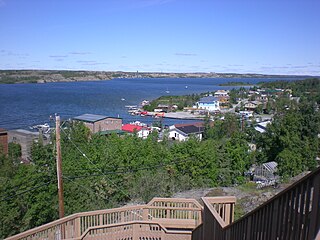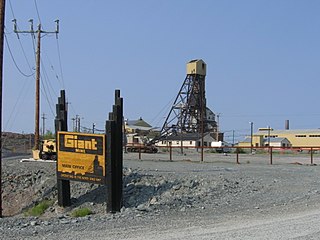
The Northwest Territories is a federal territory of Canada. At a land area of approximately 1,144,000 km2 (442,000 sq mi) and a 2016 census population of 41,790, it is the second-largest and the most populous of the three territories in Northern Canada. Its estimated population as of 2023 is 45,668. Yellowknife is the capital, most populous community, and only city in the territory; its population was 19,569 as of the 2016 census. It became the territorial capital in 1967, following recommendations by the Carrothers Commission.

Yellowknife is the capital, largest community, and only city in the Northwest Territories, Canada. It is on the northern shore of Great Slave Lake, about 400 km (250 mi) south of the Arctic Circle, on the west side of Yellowknife Bay near the outlet of the Yellowknife River.

Numbered highways in Canada are split by province, and a majority are maintained by their province or territory transportation department. With few exceptions, all highways in Canada are numbered. Nonetheless, every province has a number of highways that are better known locally by their name rather than their number. Some highways have additional letters added to their number: A is typically an alternate route, B is typically a business route, and other letters are used for bypass (truck) routes, connector routes, scenic routes, and spur routes. The territory of Nunavut has no highways.

Great Slave Lake is the second-largest lake in the Northwest Territories of Canada, the deepest lake in North America at 614 m (2,014 ft), and the tenth-largest lake in the world by area. It is 469 km (291 mi) long and 20 to 203 km wide. It covers an area of 27,200 km2 (10,500 sq mi) in the southern part of the territory. Its given volume ranges from 1,070 km3 (260 cu mi) to 1,580 km3 (380 cu mi) and up to 2,088 km3 (501 cu mi) making it the 10th or 12th largest by volume.
Enterprise is a hamlet in the South Slave Region of the Northwest Territories, Canada, located between Great Slave Lake and the Alberta border on the Hay River.

A winter road is a seasonal road only usable during the winter, i.e. it has to be re-built every year. This road typically runs over land and over frozen lakes, rivers, swamps, and sea ice. Segments of a winter road that cross an expanse of floating ice are also referred to as an ice road or an ice bridge.

The Giant Mine was a gold mine located on the Ingraham Trail, 5 km (3.1 mi) north of Yellowknife, Northwest Territories. Giant Mine was within the Kam Group, a part of the Yellowknife greenstone belt. Gold was discovered on the property and mineral claims staked in 1935 by Johnny Baker, but the true extent of the gold deposits was not known until 1944, when a massive gold-bearing shear zone was uncovered beneath the drift-filled Baker Creek Valley.

There are an estimated 850 km (530 mi) of roads and highways across the Canadian territory of Nunavut, which is the only province/territory not connected by road to other parts of Canada.

Dettah, sometimes spelled incorrectly as Detah, is a First Nations community in the North Slave Region of the Northwest Territories, Canada. Located just southeast of the capital of Yellowknife, it is a 6.5 km (4.0 mi) drive from that city by ice road across the north arm of Great Slave Lake in winter or a 27 km (17 mi) drive via the Ingraham Trail, year-round. The name means 'Burnt Point' in the Dogrib language and refers to a traditional fishing camp used by the Dene for hundreds of years.

The Jericho Diamond Mine is a dormant diamond mine located in Canada's Nunavut territory. Jericho is Nunavut’s first and only diamond mine. It is located 420 km (260 mi) northeast of Yellowknife, Northwest Territories and is accessible by air all year and by winter road from Yellowknife. The project was mined from 2006 to 2008, and produced 780,000 carats of diamonds from 1,200,000 tonnes of kimberlite mined from the open pit operation. Over $200 million was invested in the development of the Jericho operations including the construction of a 2,000 t per day diamond recovery plant, maintenance facility, fuel farm, and offices and accommodation for 225 personnel.
The Gahcho Kué Diamond Mine is located on the Canadian tundra in the Northwest Territories. It is situated at Kennady Lake, in the Akaitcho Treaty 8 Territory claim block, which is 85 km (53 mi) southeast of the Snap Lake Diamond Mine and approximately 280 km (170 mi) east northeast of Yellowknife. The site is served by Gahcho Kue Aerodrome, which has both an ice runway in winter and a year-round gravel runway, and a spur of the Tibbitt to Contwoyto Winter Road from Lupin Mine. the main camp is at 63°26′05″N109°12′02″W, north of the ice strip, with a smaller site at 63°25′48″N109°12′00″W, south of the runway.
Contwoyto Lake is a lake in the Kitikmeot Region of the Canadian territory of Nunavut, located near the border with the Northwest Territories. With a total area of 957 km2 (369 sq mi), it is the territories' tenth largest lake.

R. Timothy Patterson is a Canadian professor of geology, Chairman of the Department of Earth Sciences at Carleton University, Ottawa, Ontario, Canada, and a researcher with specialization in paleolimnology, paleoceanography, and paleoclimatology. He founded and is co-Director of the Carleton Climate and Environmental Research Group (CCERG) He has previously served as Director of the Ottawa-Carleton Geoscience Centre and as senior visiting fellow in the School of Geography, Queen's University of Belfast, Northern Ireland.

Tibbitt to Contwoyto Winter Road is an annual ice road first built in 1982 to service mines and exploration activities in the Northwest Territories and Nunavut in Northern Canada. Between 400 and 600 km long, the road is said to be the world's longest heavy haul ice road and operates for eight to ten weeks starting in the last week of January. Most of the road (85%–87%) is built over frozen lakes, 495 km (308 mi), with the remaining 73 km (45 mi) built on over 64 land portages between lakes.

Highway 4, known as the Ingraham Trail, extends from Yellowknife, Northwest Territories to Tibbitt Lake, approximately 70 km (43 mi) east of Yellowknife. It was built in the mid-1960s as the first leg of a 'road to resources' with the original intention of encircling Great Slave Lake.
This timeline of Yellowknife history summarises key events in the history of Yellowknife, a city in the Northwest Territories, Canada.
This is a list of Ice Road Truckers Season 1 episodes.
At the top of the world, there's an outpost like no other... and a job only a few would dare. The mission: To haul critical supplies across 350 miles of frozen lakes to Canada's remote billion-dollar diamond mines. The challenge: to transport 10,000 loads in 60 days—before the road disappears. The rewards are great; the risks even greater. These are the men who make their living on thin ice.

Yellowknife North is a territorial electoral district for the Legislative Assembly of the Northwest Territories, Canada. It is one of seven districts that represent Yellowknife, the territorial capital. It encompasses Old Town, Niven Heights, some of downtown, and a large rural hinterland centered on the Ingraham Trail.
Ranney Hill is a rock outcrop approximately 10 kilometers north of Yellowknife, the capital city of the Northwest Territories of Canada. At 682 ft / 208 m. high, it is one of three visible outcrops that can be seen north of the city. It is an anomaly rising from the relatively flat Canadian Shield.
Rylund Johnson is a Canadian politician, who was elected to the Legislative Assembly of the Northwest Territories in the 2019 election. He represented the electoral district of Yellowknife North.













